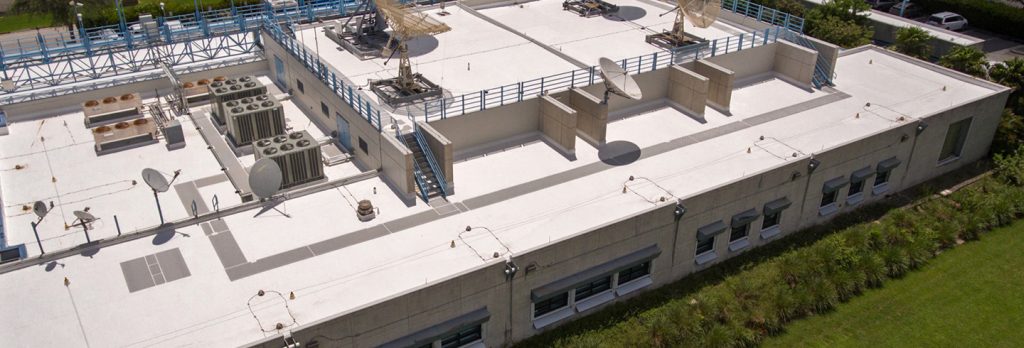National Hurricane Center

PVC (Vinyl) Roof Weathers The Storms At National Hurricane Center
ROOFING CHALLENGE: The Miami-based National Hurricane Center of the National Oceanic and Atmospheric Administration (NOAA) is the mission-critical command center for U.S. storm forecasting and tracking. Over the years, the Center’s existing BUR system had suffered soaking water intrusion around the legs of massive satellites dishes placed atop this roof, due to improper flashing around the original roof penetrations. When water began leaking into the building mechanical room below, a reroofing had to be planned and executed before the next busy extreme weather season.
PVC (VINYL) SOLUTION
In Miami-Dade County, a roof must be compliant with a special section of the Florida Building Code known as the Miami-Dade High Velocity Hazard Zone, and remain operational even through a Category 5 hurricane. On the Hurricane Wind Scale, a Category 5 event is one causing catastrophic damage, including: “A high percentage of framed homes will be destroyed, with total roof failure and wall collapse. Fallen trees and power poles will isolate residential areas. Power outages will last for weeks to possibly months. Most of the area will be uninhabitable for weeks or months.”
To withstand the onslaught of such conditions, the Center needed a premium watertight roofing system with superior wind uplift that would last 25 years or more with little maintenance. In addition, a system that could reduce building energy costs with the reflectivity of a light-colored membrane spanning 24,700 square feet would be a plus in the Florida sun.
The solution chosen for the job was a two-roof system comprised of an SBS modified torched-down vapor retarder used as a temporary roof system underneath Sika Sarnafil’s white, single-ply adhered PVC (vinyl) roof system, a 60 mil EnergySmart Roof®. The combination of these systems offered advantages that exceeded the limitations of each on its own.
The project involved very intricate work around large I-beam stands holding thousands of pounds of satellites and antennae, where at some points there was only six inches of clearance between the stands and the roof. In addition, none of this equipment could be taken offline during the project. Offsetting these rigors, though, was the relative ease of heat welding the thermoplastic PVC sheet prior to flashing securely around the complex roof penetrations.
As if on cue, weeks after the roof of the National Hurricane Center was completed, Hurricane Matthew slammed into Florida. Although the Category 5 hurricane had weakened to a tropical storm by the time it reached Miami, the absence of any damage gave NOAA and the Center peace of mind about the new roof’s capabilities. The roof has performed similarly in subsequent storms such as Irma, a Category 4 hurricane that made landfall carrying sustained winds of up to 112 miles per hour.
“The roof is going nowhere,” says Matt Cooper, project manager for Advanced Roofing, Inc. of Fort Lauderdale, the roofing contractor on the project.
View a video about another roofing project where durability and flashing around complex roof penetrations was a critical consideration in selecting PVC (vinyl) roofing material.

